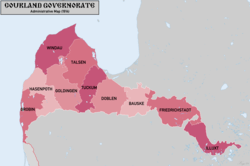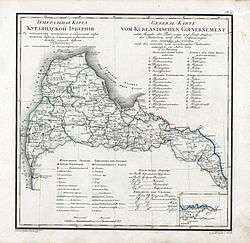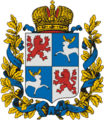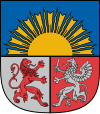Courland Governorate
| Courland Governorate Курляндская губерния Kurlyandskaya guberniya | ||||||
| Governorate of the Russian Empire | ||||||
| ||||||
| ||||||
 | ||||||
| Capital | Jelgava (until 1915) | |||||
| History | ||||||
| • | Partition of Poland | 28 March 1795 | ||||
| • | German occupation | 1918 | ||||
| • | Treaty of Brest-Litovsk | 1918 | ||||
| Population | ||||||
| • | (1897) | 674,034 | ||||
| Political subdivisions | 9 | |||||
Courland Governorate, also known as the Province of Courland,[1] Governorate of Kurland[2] (Russian: Курля́ндская губерния), and Government of Courland (German: Kurländisches Gouvernement, Latvian: Kurzemes guberņa), was one of the Baltic governorates of the Russian Empire, that is now part of the Republic of Latvia.

The governorate was created in 1795 out of the territory of the Duchy of Courland and Semigallia that was incorporated into the Russian Empire as the province of Courland with its capital at Jelgava (called Mitau at the time), following the third partition of the Polish-Lithuanian Commonwealth. Until the late 19th century the governorate was not ruled by Russia but was administered independently by the local Baltic German nobility through a feudal Regional Council (German: Landtag).[3]
The governorate was bounded in north by the Baltic Sea, the Gulf of Riga and the Governorate of Livonia; west by the Baltic Sea; south by the Vilna Governorate and Prussia and east by the Vitebsk Governorate and Minsk Governorate. The population in 1846 was estimated at 553,300.[1]
It ceased to exist during World War I after the German Empire took control of the region in 1918. Russia surrendered the territory by the Treaty of Brest-Litovsk on 3 March 1918.
Subdivisions
List of governors
Between 1800 and 1876 overall authority in Courland was handed to the governor-general of the Baltic Provinces (German: Generalgouverneur der Ostseeprovinzen).
- 1795 – 1796 Peter Ludwig Freiherr von der Pahlen (temporary governor-general of Courland and Pilten)
- 1796 – 1798 Gustav Matthias Jakob von der Wenge
- 1798 – 1800 Carl Wilhelm Heinrich Freiherr von der Osten-Drizen
- 1800 – 1808 Nikolay Ivanovich Arsenyev
- 1808 Jakob Maximilian von Brieskorn (acting governor on 18–21 May 1812)
- 1808 – 1811 Johann Wilhelm Baron von Hogguer
- 1811 Jakob Maximilian von Brieskorn (acting governor in August–September 1812)
- 1811 – 1816 Friedrich Wilhelm Graf von Sievers (in exile in Riga during Napoleonic invasion of Courland in July–December 1812)
- 1812 Jules de Chambaudoin and Charles de Montigny (French intendants of Courland, Semigallia and Pilten on 1 August-8 October 1812)
- 1812 Jacques David Martin (French governor-general of Courland on 8 October-20 December 1812)
- 1816 – 1824 Emannuel von Stanecke
- 1824 – 1827 Paul Theodor von Hahn (1793–1862)
- 1827 – 1853 Christoph Engelbrecht von Brevern (de)
- 1853 Aleksandr Petrovich Beklemishev (acting governor on 10 May–14 June 1853)
- 1853 – 1858 Pyotr Aleksandrovich Valuyev
- 1858 Julius Gustav von Cube (acting governor on 10–21 May 1858)
- 1858 – 1868 Johann von Brevern
- 1868 – 1885 Paul Fromhold Freiherr von Lilienfeld
- 1885 Aleksandr Alekseyevich Manyos
- 1885 – 1888 Konstantin Ivanovich Pashchenko
- 1888 – 1891 Dimitriy Sergeyevich Sipyagin
- 1891 – 1905 Dimitriy Dimitriyevich Sverbeyev
- 1905 – 1906 Woldemar von Böckmann
- 1906 – 1910 Leonid Mikhailovich Knyazev
- 1910 Nikolay Dmitriyevich Kropotkin
- 1910 – 1915 Sergey Dimitriyevich Nabokov
- 1915–1917 Tatishchev, Pyotr Vasilyevich Gendrikov, Strakhov (in exile in Tartu after German invasion of Courland in July 1915).
In March 1918 the Baltic provinces were transferred to German authority following the Treaty of Brest-Litovsk.
Language
- By the Imperial census of 1897.[4] In bold are languages spoken by more people than the state language.
| Language | Number | percentage (%) | males | females |
|---|---|---|---|---|
| Latvian | 507 511 | 75.29 | 240 672 | 266 839 |
| German | 51 017 | 7.56 | 23 372 | 27 645 |
| Yiddish | 37 689 | 5.59 | 18 137 | 19 552 |
| Russian | 25 630 | 3.8 | 16 319 | 9 311 |
| Polish | 19 688 | 2.92 | 9 985 | 9 703 |
| Lithuanian | 16 531 | 2.45 | 8 833 | 7 698 |
| Belarusian | 12 283 | 1.82 | 6 356 | 5 927 |
| Romani | 1 202 | 0.17 | 581 | 621 |
| Persons that didn't name their native language |
5 | >0.01 | 4 | 1 |
| Other[5] | 2 478 | 0.36 | 1 993 | 485 |
| Total | 674 034 | 100 | 326 252 | 347 782 |
See also
References and notes
- 1 2 The English Cyclopaedia By Charles Knigh
- ↑ The Baltic States from 1914 to 1923 By LtCol Andrew Parrott Archived 19 March 2009 at the Wayback Machine.
- ↑ Smith, David James (2005). The Baltic States and Their Region. Rodopi. ISBN 978-90-420-1666-8.
- ↑ Language Statistics of 1897 (in Russian)
- ↑ Languages, number of speakers which in all gubernia were less than 1000
 |


